Effects of Submerged Vegetation Arrangement Patterns and Density on Flow Structure
Abstract
:1. Introduction
2. Materials and Methods
2.1. Flume, ADV, and SonTek IQ Used for This Study
2.2. Sediment Used in Experiments
2.3. Vegetation Settings
3. Results and Discussions
3.1. Velocity
3.1.1. Effects of Vegetation Density on Streamwise Velocity
3.1.2. Effects of Water Depth of Streamwise Velocity
3.1.3. Effects of Square Arrangement on Velocity Profile
3.1.4. Effects of Staggered Arrangement on Velocity Profile
3.1.5. Velocity Contours in Square Arrangement
3.2. Turbulence Kinetic Energy (TKE)
3.3. Shear Stress
4. Conclusions
Author Contributions
Funding
Institutional Review Board Statement
Informed Consent Statement
Data Availability Statement
Conflicts of Interest
References
- Fathi-Moghadam, M.; Drikvandi, K.H.; Lashkarara, B.; Hammadi, K. Determination of Friction Factor for Rivers with Nonsubmerged Vegetation in Banks and Floodplains. Sci. Res. Essays 2011, 6, 4714–4719. [Google Scholar]
- Kouwen, N. Modern Approach to Design of Grassed Channels. J. Irrig. Drain. Eng. 1992, 118, 733–743. [Google Scholar] [CrossRef]
- Nedjimi, B.; Beladel, B.; Guit, B. Biodiversity of Halophytic Vegetation in Chott Zehrez Lake of Djelfa (Algeria). Am. J. Plant Sci. 2012, 3, 1527–1534. [Google Scholar] [CrossRef] [Green Version]
- Waycott, M.; Longstaff, B.; Mellors, J. Seagrass Population Dynamics and Water Quality in the Great Barrier Reef Region: A Review and Future Research Directions. Mar. Pollut. Bull. 2005, 51, 343–350. [Google Scholar] [CrossRef] [PubMed]
- Short, F.T.; Short, C.A.; Novak, A.B. Seagrasses. In The Wetland Book; Finlayson, C.M., Milton, G.R., Prentice, R.C., Davidson, N.C., Eds.; Springer: Dordrecht, The Netherlands, 2016; pp. 1–19. ISBN 978-94-007-6173-5. [Google Scholar]
- López, F.; García, M. Open-Channel Flow Through Simulated Vegetation: Turbulence Modeling and Sediment Transport; US Army Engineer Waterways Experiment Station: Vicksburg, MS, USA, 1997. [Google Scholar]
- Neumeier, U.; Ciavola, P. Flow Resistance and Associated Sedimentary Processes in a Spartina Maritima Salt-Marsh. J. Coast. Res. 2004, 202, 435–447. [Google Scholar]
- Shahmohammadi, R.; Afzalimehr, H.; Sui, J. Impacts of Turbulent Flow over a Channel Bed with a Vegetation Patch on the Incipient Motion of Sediment. Can. J. Civ. Eng. 2018, 45, 803–816. [Google Scholar] [CrossRef]
- Vandenbruwaene, W.; Temmerman, S.; Bouma, T.J.; Klaassen, P.C.; de Vries, M.B.; Callaghan, D.P.; van Steeg, P.; Dekker, F.; van Duren, L.A.; Martini, E.; et al. Flow Interaction with Dynamic Vegetation Patches: Implications for Biogeomorphic Evolution of a Tidal Landscape: FLOW INTERACTION WITH DYNAMIC PATCHES. J. Geophys. Res. Earth Surf. 2011, 116, F01008. [Google Scholar] [CrossRef] [Green Version]
- Trimble, S.W. Stream Channel Erosion and Change Resulting from Riparian Forests. Geology 1997, 25, 467–469. [Google Scholar] [CrossRef]
- Chen, S.C.; Kuo, Y.M.; Li, Y.H. Flow Characteristics within Different Configurations of Submerged Flexible Vegetation. J. Hydrol. 2011, 398, 124–134. [Google Scholar] [CrossRef]
- Zhang, J.; Lei, J.; Huai, W.; Nepf, H. Turbulence and Particle Deposition Under Steady Flow Along a Submerged Seagrass Meadow. J. Geophys. Res. Oceans 2020, 125, e2019JC015985. [Google Scholar] [CrossRef]
- Kabiri, F.; Afzalimehr, H.; Sui, J. Flow structure over a wavy bed with vegetation cover. Int. J. Sediment Res. 2017, 32, 186–194. [Google Scholar] [CrossRef]
- Pollen, N.; Simon, A. Estimating the Mechanical Effects of Riparian Vegetation on Stream Bank Stability Using a Fiber Bundle Model: Modeling root reinforcement of stream banks. Water Resour. Res. 2005, 41, W07025. [Google Scholar] [CrossRef]
- Afzalimehr, H.; Dey, S. Influence of Bank Vegetation and Gravel Bed on Velocity and Reynolds Stress Distributions. Int. J. Sediment Res. 2009, 24, 236–246. [Google Scholar] [CrossRef]
- Barbier, E.B.; Hacker, S.D.; Kennedy, C.; Koch, E.W.; Stier, A.C.; Silliman, B.R. The Value of Estuarine and Coastal Ecosystem Services. Ecol. Monogr. 2011, 81, 169–193. [Google Scholar] [CrossRef]
- Arkema, K.K.; Griffin, R.; Maldonado, S.; Silver, J.; Suckale, J.; Guerry, A.D. Linking Social, Ecological, and Physical Science to Advance Natural and Nature-Based Protection for Coastal Communities: Advancing Protection for Coastal Communities. Ann. N. Y. Acad. Sci. 2017, 1399, 5–26. [Google Scholar] [CrossRef]
- Yu, G.A.; Li, Z.; Yang, H.; Lu, J.; Huang, H.Q.; Yi, Y. Effects of Riparian Plant Roots on the Unconsolidated Bank Stability of Meandering Channels in the Tarim River, China. Geomorphology 2020, 351, 106958. [Google Scholar] [CrossRef]
- Sanchez-Gonzalez, J.; Sanchez-Rojas, V.; Memos, C. Wave Attenuation Due to Posidonia Oceanica Meadows. J. Hydraul. Res. 2011, 49, 503–514. [Google Scholar] [CrossRef]
- Hansen, J.; Reidenbach, M. Wave and Tidally Driven Flows in Eelgrass Beds and Their Effect on Sediment Suspension. Mar. Ecol. Prog. Ser. 2012, 448, 271–287. [Google Scholar] [CrossRef] [Green Version]
- Schleiss, A.J.; Franca, M.J.; Juez, C.; De Cesare, G. Reservoir Sedimentation. J. Hydraul. Res. 2016, 54, 595–614. [Google Scholar] [CrossRef]
- Ros, À.; Colomer, J.; Serra, T.; Pujol, D.; Soler, M.; Casamitjana, X. Experimental Observations on Sediment Resuspension within Submerged Model Canopies under Oscillatory Flow. Cont. Shelf Res. 2014, 91, 220–231. [Google Scholar] [CrossRef]
- Serra, T.; Oldham, C.; Colomer, J. Local Hydrodynamics at Edges of Marine Canopies under Oscillatory Flows. PLoS ONE 2018, 13, e0201737. [Google Scholar] [CrossRef] [PubMed]
- Zhang, Y.; Tang, C.; Nepf, H. Turbulent Kinetic Energy in Submerged Model Canopies Under Oscillatory Flow. Water Resour. Res. 2018, 54, 1734–1750. [Google Scholar] [CrossRef]
- Tinoco, R.O.; Coco, G. Turbulence as the Main Driver of Resuspension in Oscillatory Flow Through Vegetation. J. Geophys. Res. Earth Surf. 2018, 123, 891–904. [Google Scholar] [CrossRef]
- Bouma, T.J.; van Duren, L.A.; Temmerman, S.; Claverie, T.; Blanco-Garcia, A.; Ysebaert, T.; Herman, P.M.J. Spatial Flow and Sedimentation Patterns within Patches of Epibenthic Structures: Combining Field, Flume and Modelling Experiments. Cont. Shelf Res. 2007, 27, 1020–1045. [Google Scholar] [CrossRef]
- Temmerman, S.; Bouma, T.J.; Van de Koppel, J.; Van der Wal, D.; De Vries, M.B.; Herman, P.M.J. Vegetation Causes Channel Erosion in a Tidal Landscape. Geology 2007, 35, 631. [Google Scholar] [CrossRef]
- Nepf, H.M. Hydrodynamics of Vegetated Channels. J. Hydraul. Res. 2012, 50, 262–279. [Google Scholar] [CrossRef] [Green Version]
- Belcher, S.E.; Jerram, N.; Hunt, J.C.R. Adjustment of a Turbulent Boundary Layer to a Canopy of Roughness Elements. J. Fluid Mech. 2003, 488, 369–398. [Google Scholar] [CrossRef] [Green Version]
- Chow, V.T. Open-Channel Hydraulics; McGraw-Hill Civil Engineering Series; Blackburn Press: Blackburn, UK, 2009; ISBN 1-932846-18-2. [Google Scholar]
- Sontek, A.D.V. Operation Manual, Firmware Version 4.0; Sontek: San Diego, CA, USA, 1997. [Google Scholar]
- Goring, D.G.; Nikora, V.I. Despiking Acoustic Doppler Velocimeter Data. J. Hydraul. Eng. 2002, 128, 117–126. [Google Scholar] [CrossRef] [Green Version]
- Wahl, T.L. Discussion of “Despiking Acoustic Doppler Velocimeter Data” by Derek G. Goring and Vladimir I. Nikora. J. Hydraul. Eng. 2003, 129, 484–487. [Google Scholar] [CrossRef] [Green Version]
- Lowe, R.J.; Koseff, J.R.; Monismith, S.G. Oscillatory Flow through Submerged Canopies: 1. Velocity Structure. J. Geophys. Res. 2005, 110, C10016. [Google Scholar] [CrossRef] [Green Version]
- Abdolahpour, M.; Ghisalberti, M.; Lavery, P.; McMahon, K. Vertical Mixing in Coastal Canopies: Vertical Mixing in Coastal Canopies. Limnol. Oceanogr. 2017, 62, 26–42. [Google Scholar] [CrossRef]
- Nabaei, S.F.; Afzalimehr, H.; Sui, J.; Kumar, B.; Nabaei, S.H. Investigation of the Effect of Vegetation on Flow Structures and Turbulence Anisotropy around Semi-Elliptical Abutment. Water 2021, 13, 3108. [Google Scholar] [CrossRef]
- SonTek-IQ Series Intelligent Flow Featuring Smart Puls HD User’s Manual; Xylem Inc: San Diego, CA, USA, 2017; p. 135.
- Blott, S.J.; Pye, K. GRADISTAT: A Grain Size Distribution and Statistics Package for the Analysis of Unconsolidated Sediments. Earth Surf. Process. Landf. 2001, 26, 1237–1248. [Google Scholar] [CrossRef]
- Hager, W.H. Wastewater Hydraulics: Theory and Practice, 2nd ed.; Springer: Berlin, Germany; London, UK, 2010; ISBN 978-3-642-11383-3. [Google Scholar]
- Huai, W.; Zhang, J.; Katul, G.G.; Cheng, Y.; Tang, X.; Wang, W. The Structure of Turbulent Flow through Submerged Flexible Vegetation. J. Hydrodyn. 2019, 31, 274–292. [Google Scholar] [CrossRef]
- Siniscalchi, F.; Nikora, V.I.; Aberle, J. Plant Patch Hydrodynamics in Streams: Mean Flow, Turbulence, and Drag Forces: Plant patch hydrodynamics. Water Resour. Res. 2012, 48, W01513. [Google Scholar] [CrossRef] [Green Version]
- Aberle, J.; Järvelä, J. Hydrodynamics of Vegetated Channels. In Rivers–Physical, Fluvial and Environmental Processes; Rowiński, P., Radecki-Pawlik, A., Eds.; Springer International Publishing: Cham, Switzerland, 2015; pp. 519–541. ISBN 978-3-319-17718-2. [Google Scholar]
- Nikora, V. Hydrodynamics of Aquatic Ecosystems: An Interface between Ecology, Biomechanics and Environmental Fluid Mechanics. River Res. Appl. 2010, 26, 367–384. [Google Scholar] [CrossRef]
- Nepf, H.M.; Vivoni, E.R. Flow Structure in Depth-Limited, Vegetated Flow. J. Geophys. Res. Oceans 2000, 105, 28547–28557. [Google Scholar] [CrossRef]
- Raupach, M.R.; Finnigan, J.J.; Brunei, Y. Coherent Eddies and Turbulence in Vegetation Canopies: The Mixing-Layer Analogy. Bound.-Layer Meteorol. 1996, 78, 351–382. [Google Scholar] [CrossRef]
- Petryk, S.; Bosmajian, G. Analysis of Flow through Vegetation. J. Hydraul. Div. 1975, 101, 871–884. [Google Scholar] [CrossRef]
- Nepf, H.M. Drag, Turbulence, and Diffusion in Flow through Emergent Vegetation. Water Resour. Res. 1999, 35, 479–489. [Google Scholar] [CrossRef]
- Nezu, I.; Sanjou, M. Turburence Structure and Coherent Motion in Vegetated Canopy Open-Channel Flows. J. Hydro-Environ. Res. 2008, 2, 62–90. [Google Scholar] [CrossRef]
- Nepf, H.; Ghisalberti, M. Flow and Transport in Channels with Submerged Vegetation. Acta Geophys. 2008, 56, 753–777. [Google Scholar] [CrossRef]
- Huai, W.; Li, S.; Katul, G.G.; Liu, M.; Yang, Z. Flow Dynamics and Sediment Transport in Vegetated Rivers: A Review. J. Hydrodyn. 2021, 33, 400–420. [Google Scholar] [CrossRef]
- Etminan, V.; Lowe, R.J.; Ghisalberti, M. A New Model for Predicting the Drag Exerted by Vegetation Canopies: New model for vegetation drag. Water Resour. Res. 2017, 53, 3179–3196. [Google Scholar] [CrossRef]
- Nepf, H.M. Flow and Transport in Regions with Aquatic Vegetation. Annu. Rev. Fluid Mech. 2012, 44, 123–142. [Google Scholar] [CrossRef] [Green Version]
- Afzalimehr, H.; Rennie, C.D. Determination of Bed Shear Stress in Gravel-Bed Rivers Using Boundary-Layer Parameters. Hydrol. Sci. J. 2009, 54, 147–159. [Google Scholar] [CrossRef] [Green Version]
- Schlichting, H.; Gersten, K. Boundary-Layer Theory; Springer: Berlin/Heidelberg, Germany, 2000; ISBN 978-3-642-85831-4. [Google Scholar]
- Clauser, F.H. The Turbulent Boundary Layer. In Advances in Applied Mechanics; Elsevier: Amsterdam, The Netherlands, 1956; Volume 4, pp. 1–51. ISBN 978-0-12-002004-1. [Google Scholar]
- Dyer, K.R. Sediment Processes in Estuaries: Future Research Requirements. J. Geophys. Res. 1989, 94, 14327–14339. [Google Scholar] [CrossRef]
- Kazem, M.; Afzalimehr, H.; Sui, J. Characteristics of Turbulence in the Downstream Region of a Vegetation Patch. Water 2021, 13, 3468. [Google Scholar] [CrossRef]
- Shi, Z.; Pethick, J.S.; Burd, F.; Murphy, B. Velocity Profiles in a Salt Marsh Canopy. Geo-Mar. Lett. 1996, 16, 319–323. [Google Scholar] [CrossRef]
- Afzalimehr, H.; Barahimi, M.; Sui, J. Non-Uniform Flow over Cobble Bed with Submerged Vegetation Strip. Proc. Inst. Civ. Eng.-Water Manag. 2017, 172, 86–101. [Google Scholar] [CrossRef] [Green Version]
- Raupach, M.; Shaw, R. Averaging Procedures for Flow within Vegetation Canopies. Bound Lay Met 1982, 22, 79–90. [Google Scholar] [CrossRef]
- Chen, Z.; Ortiz, A.; Zong, L.; Nepf, H. The Wake Structure behind a Porous Obstruction and Its Implications for Deposition near a Finite Patch of Emergent Vegetation. Water Resour. Res. 2012, 48, W09517. [Google Scholar] [CrossRef]
- Afzalimehr, H.; Moghbel, R.; Gallichand, J.; Sui, J. Investigation of Turbulence Characteristics in Channel with Dense Vegetation. Int. J. Sediment Res. 2011, 26, 269–282. [Google Scholar] [CrossRef]
- Raupach, M.R. Drag and Drag Partition on Rough Surfaces. Bound.-Layer Meteorol. 1992, 60, 375–395. [Google Scholar] [CrossRef]
- Leonard, L.A.; Croft, A.L. The Effect of Standing Biomass on Flow Velocity and Turbulence in Spartina Alterniflora Canopies, Estuarine. Coast. Shelf Sci. 2006, 69, 325–336. [Google Scholar] [CrossRef]
- Neumeier, U.; Amos, C.L. The Influence of Vegetation on Turbulence and Flow Velocities in European Salt-Marshes. Sedimentology 2006, 53, 259–277. [Google Scholar] [CrossRef] [Green Version]
- Nosrati, K.; Afzalimehr, H.; Sui, J. Drag Coefficient of Submerged Flexible Vegetation Patches in Gravel Bed Rivers. Water 2022, 14, 743. [Google Scholar] [CrossRef]
- Kazem, M.; Afzalimehr, H.; Sui, J. Formation of Coherent Flow Structures beyond Vegetation Patches in Channel. Water 2021, 13, 2812. [Google Scholar] [CrossRef]
- Brahimi, M.; Afzalimehr, H. Effect of Submerged Vegetation Density on Flow under Favorable Pressure Gradient. SN Appl. Sci. 2019, 1, 57. [Google Scholar] [CrossRef]
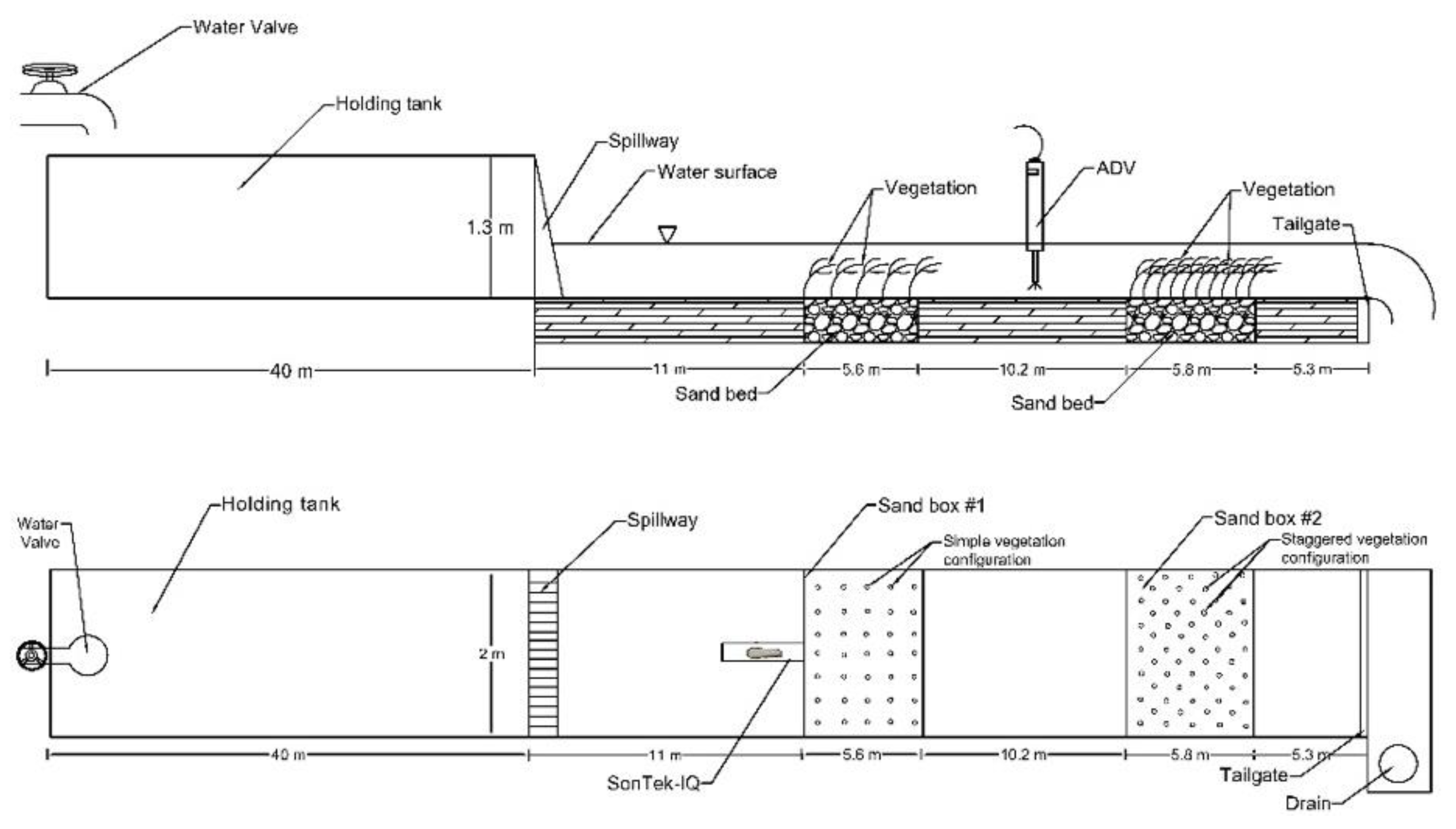

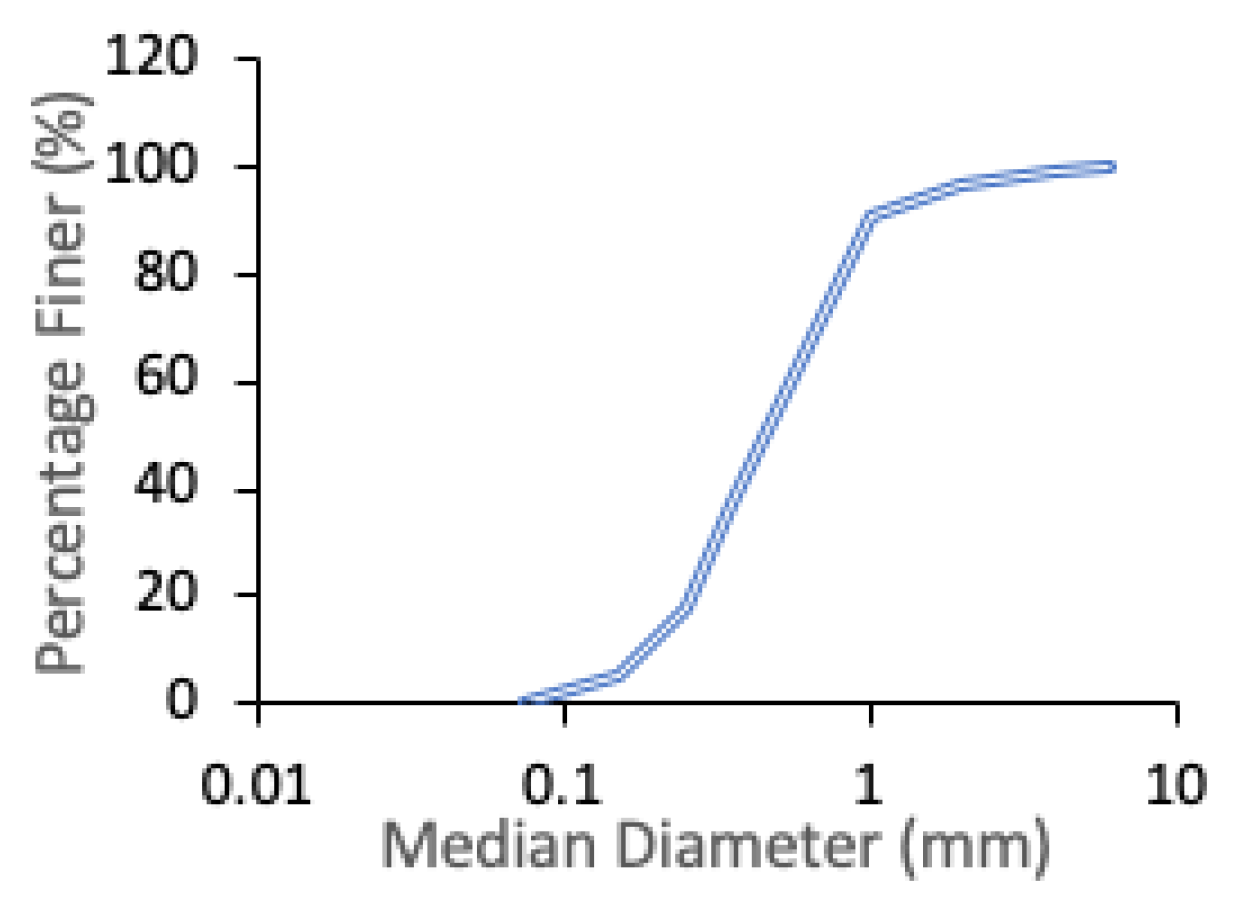


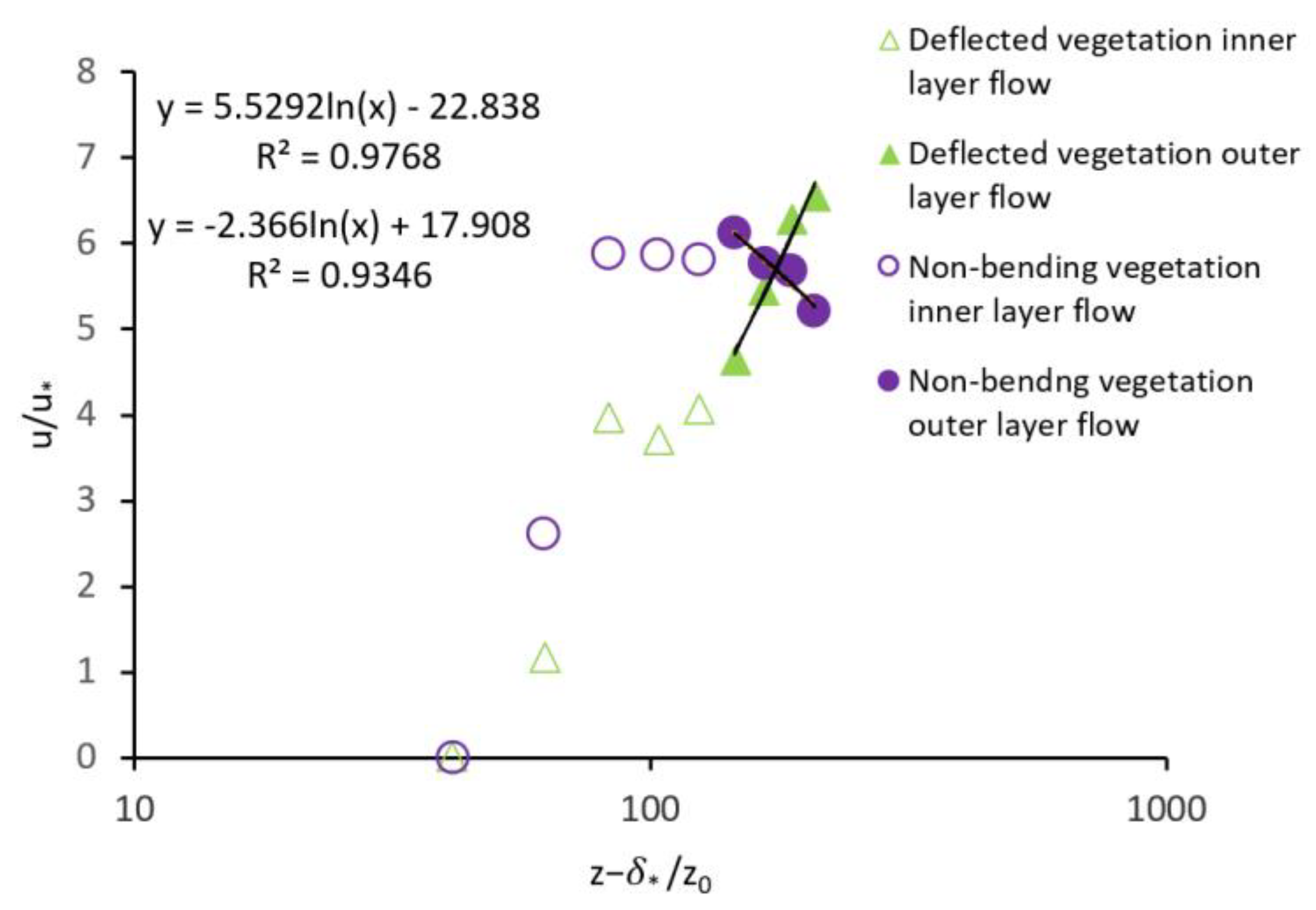
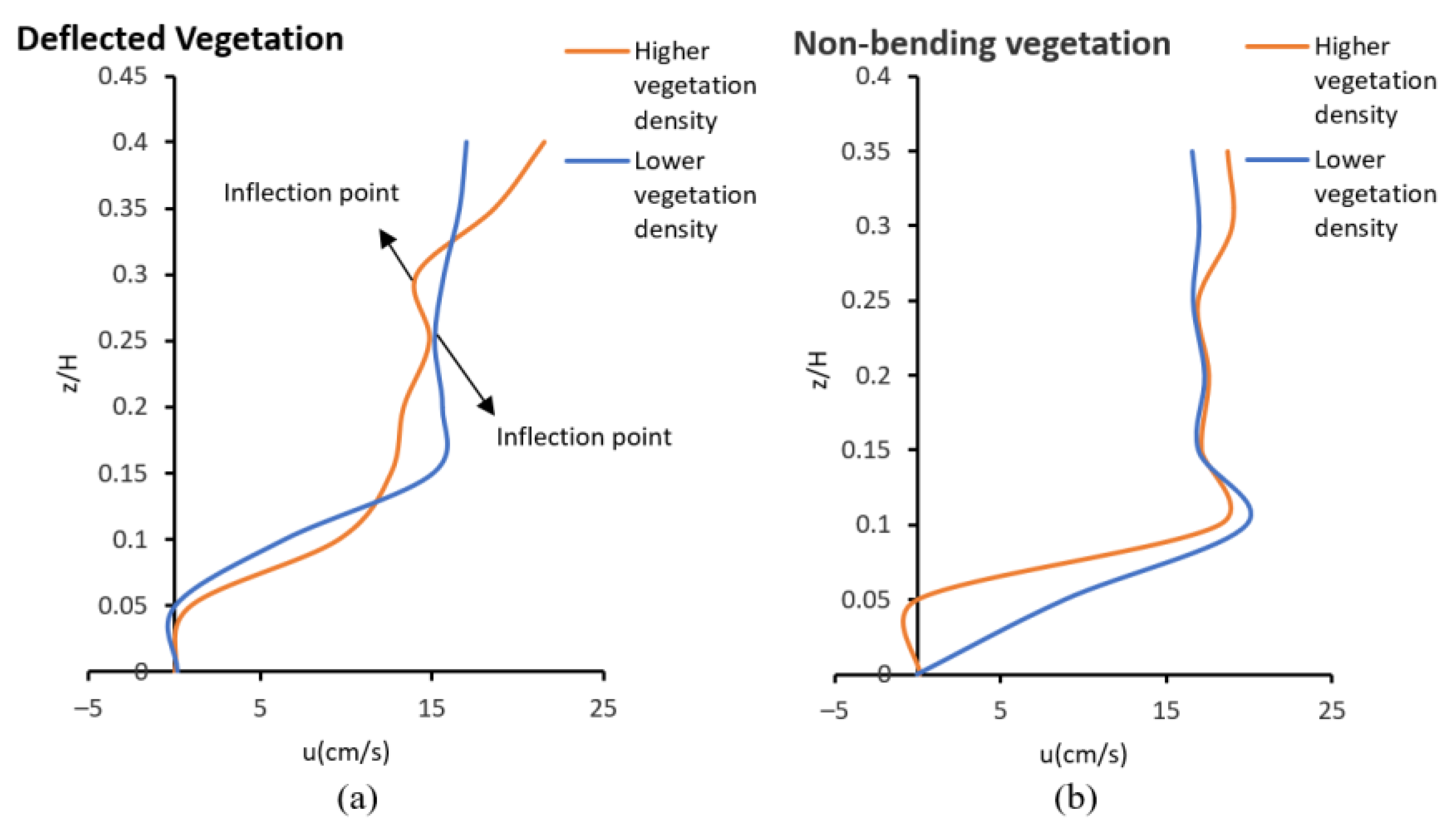
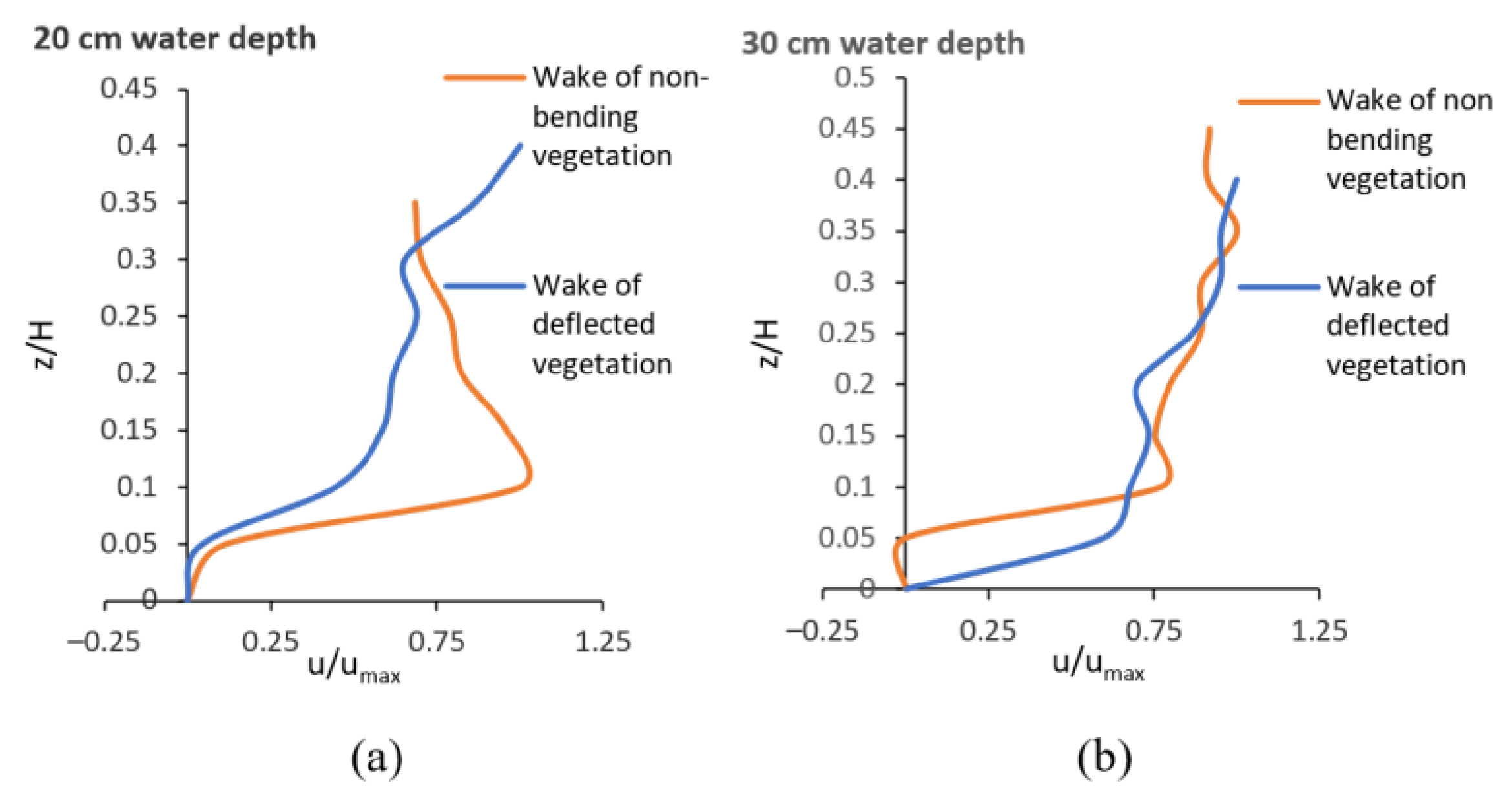
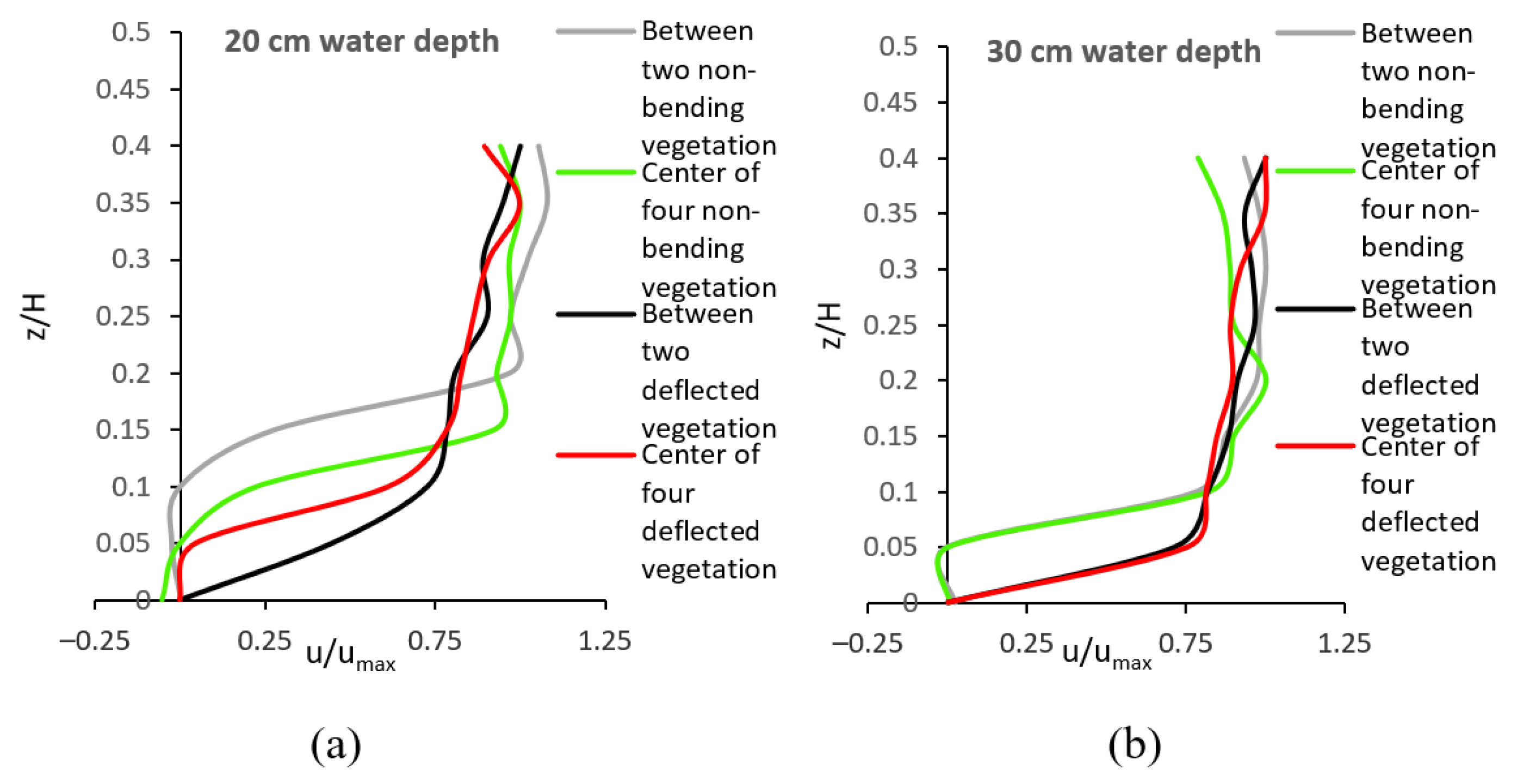

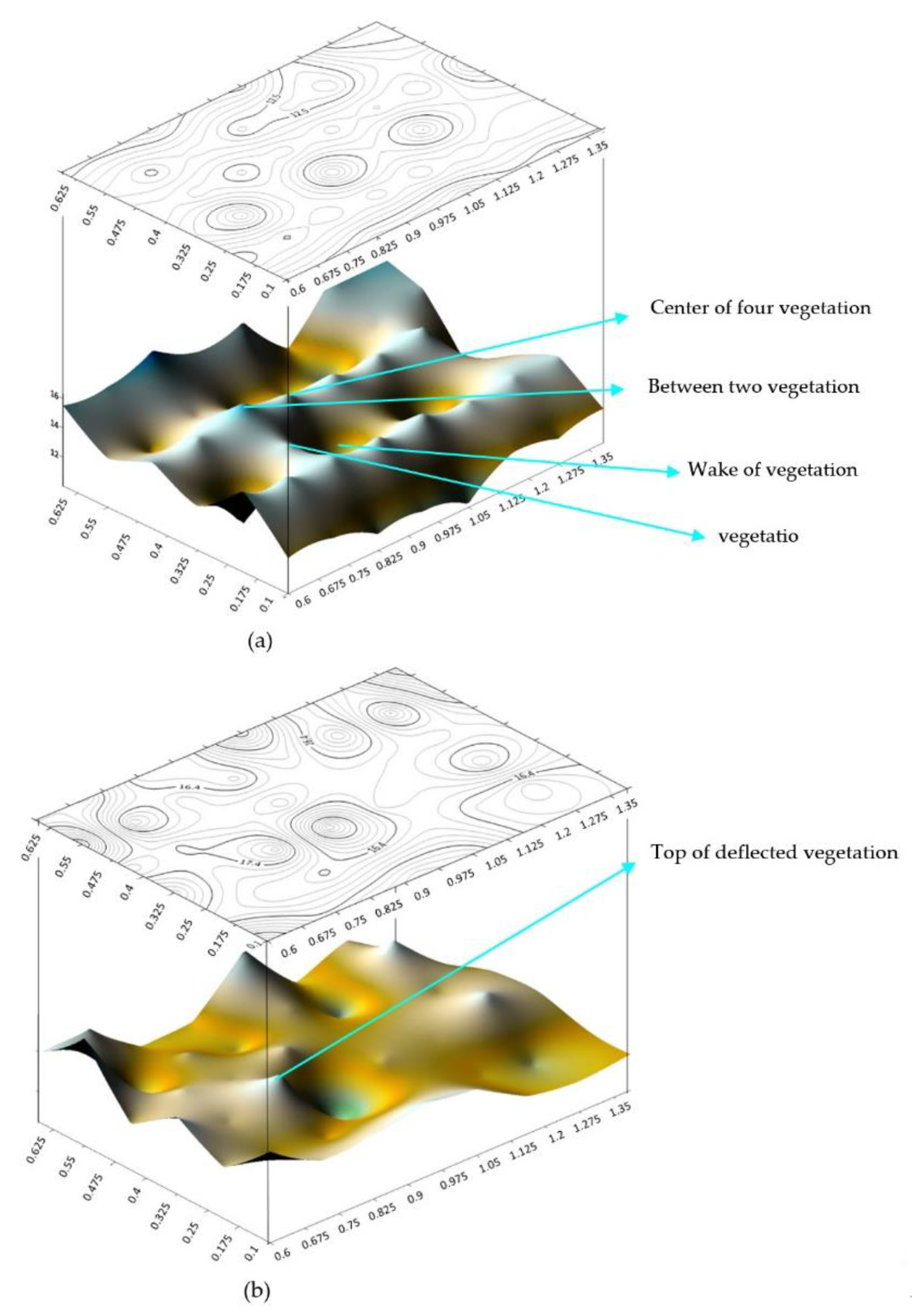
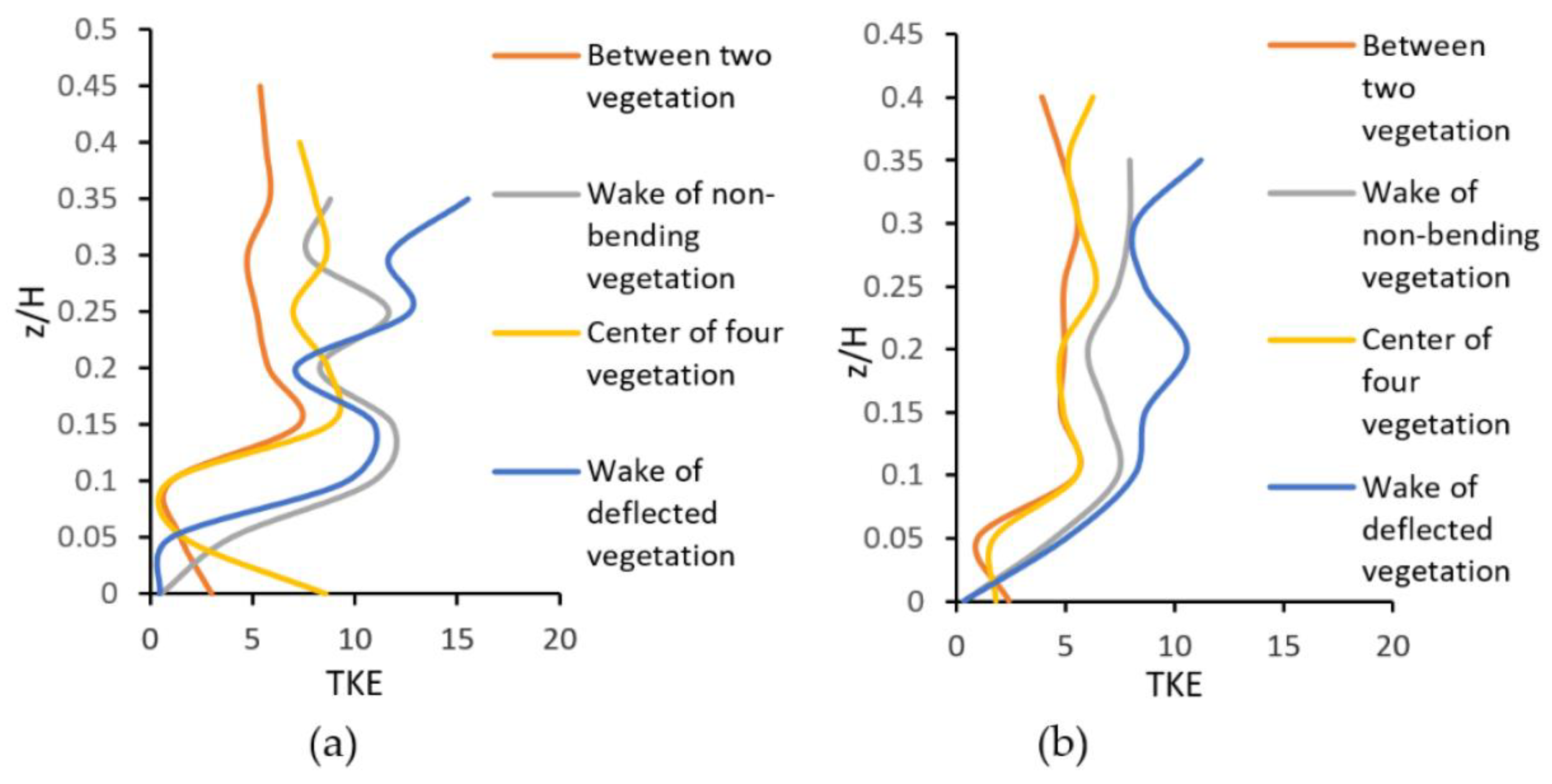
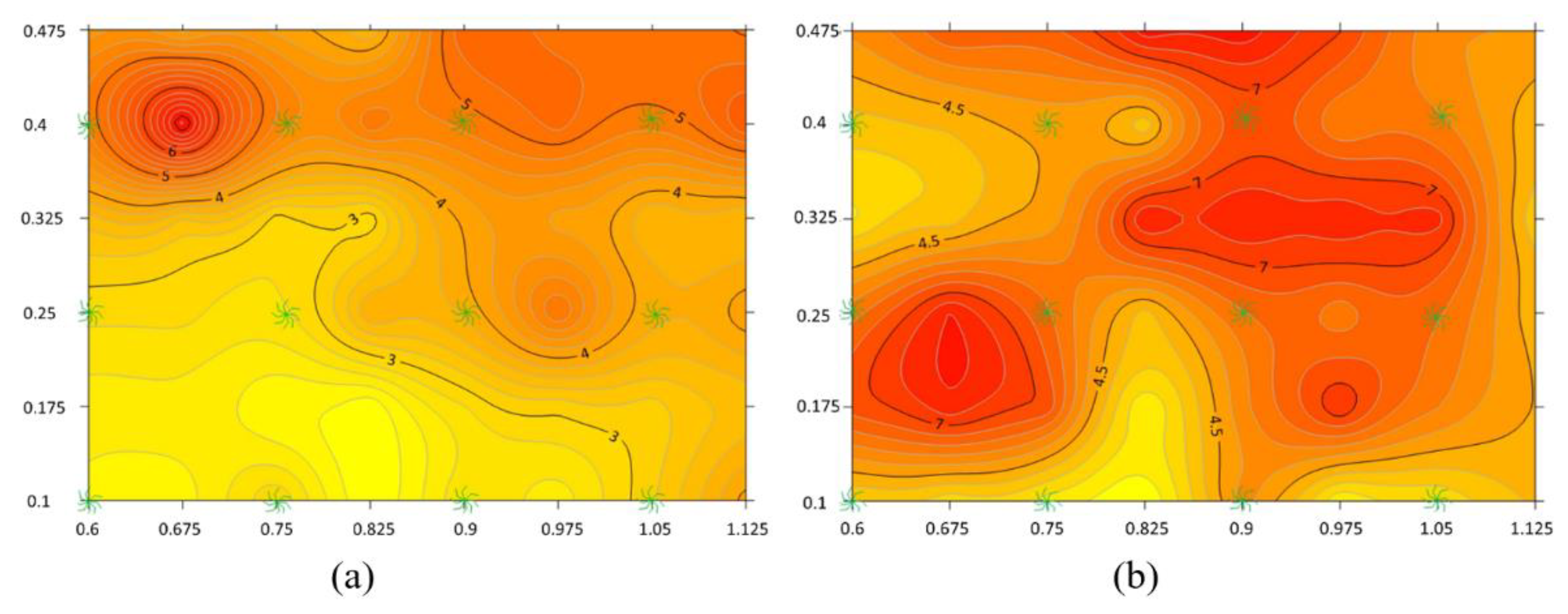
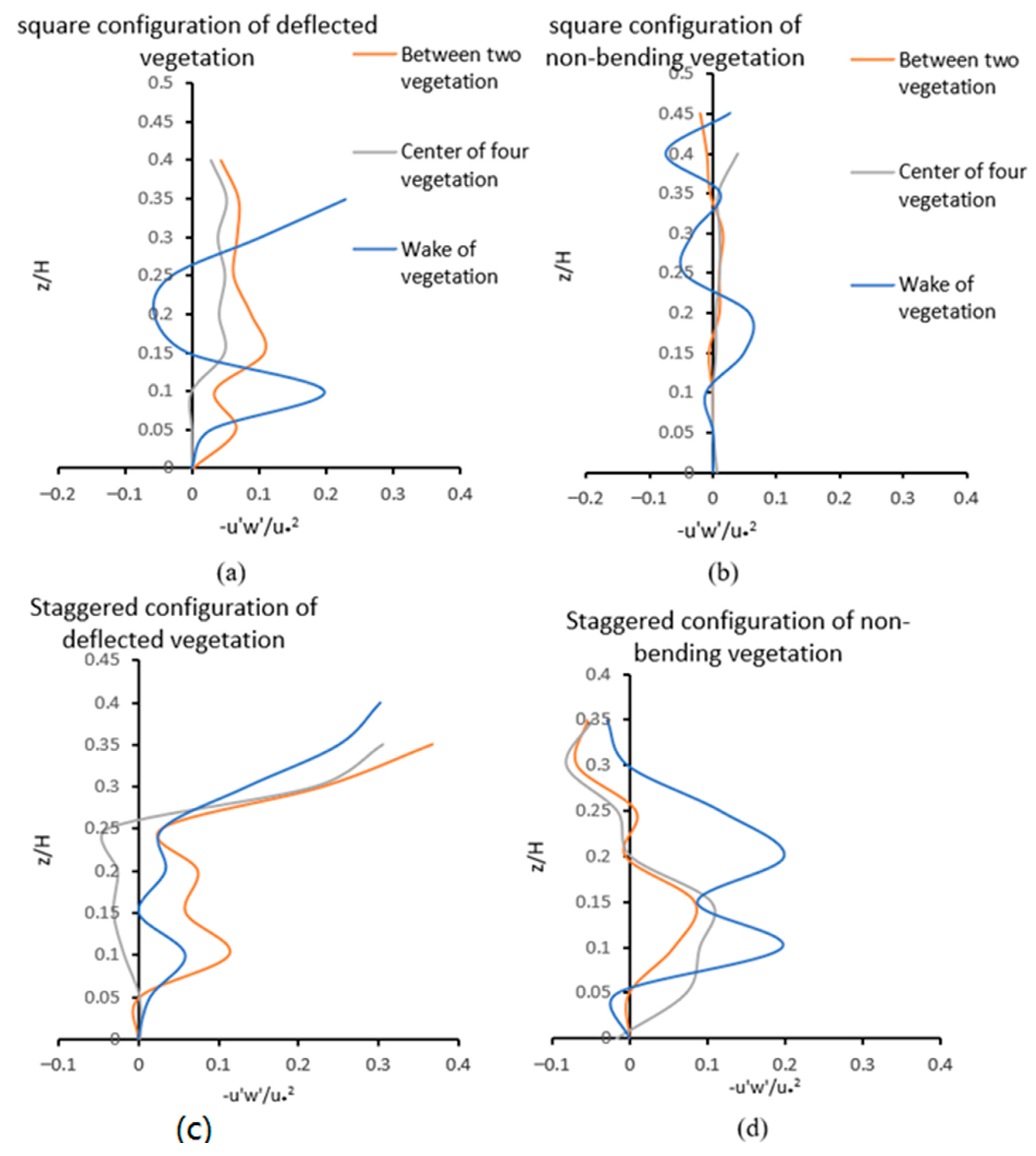
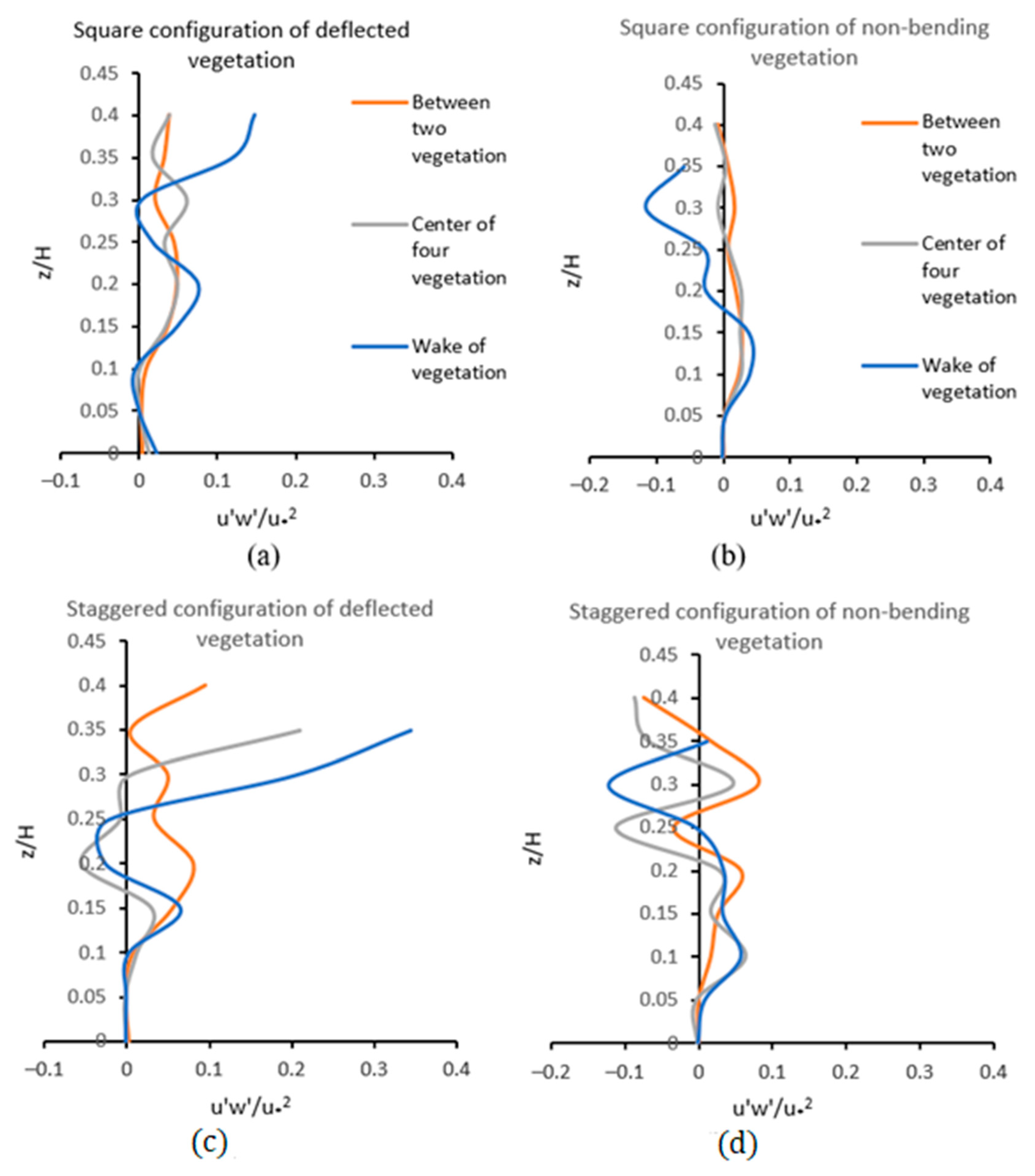
| Configuration of Vegetation Elements | Vegetation Density | Canopy Density (λ = ah) |
|---|---|---|
| Square non-bending | 0.624 | 0.12 |
| Square deflected | 0.09 | |
| Staggered non-bending | 1.2 | 0.23 |
| Staggered deflected | 0.17 | |
| Square non-bending | 0.256 | 0.05 |
| Square deflected | 0.04 | |
| Staggered non-bending | 0.506 | 0.1 |
| Staggered deflected | 0.07 |
| Configuration | Flexibility | U (cm/s) | λ | (cm/s) | h/H | ||
|---|---|---|---|---|---|---|---|
| square | 16 | deflected | 15.15 | 2423.52 | 0.0487 | 3.08 | 2 |
| non-bending | 17.31 | 2770.35 | 0.0359 | 2.94 | 1.3 | ||
| 36 | deflected | 14.87 | 2378.56 | 0.0874 | 3.42 | 2 | |
| non-bending | 17.58 | 2813.30 | 0.1186 | 3.49 | 1.3 | ||
| staggered | 32 | deflected | 14.73 | 2356.67 | 0.0961 | 2.56 | 2 |
| non-bending | 18.11 | 2897.52 | 0.0709 | 3.16 | 1.3 | ||
| 72 | deflected | 12.46 | 1993.90 | 0.168 | 2.68 | 2 | |
| non-bending | 16.93 | 2708.75 | 0.228 | 3.49 | 1.3 |
Disclaimer/Publisher’s Note: The statements, opinions and data contained in all publications are solely those of the individual author(s) and contributor(s) and not of MDPI and/or the editor(s). MDPI and/or the editor(s) disclaim responsibility for any injury to people or property resulting from any ideas, methods, instructions or products referred to in the content. |
© 2023 by the authors. Licensee MDPI, Basel, Switzerland. This article is an open access article distributed under the terms and conditions of the Creative Commons Attribution (CC BY) license (https://creativecommons.org/licenses/by/4.0/).
Share and Cite
Barahimi, M.; Sui, J. Effects of Submerged Vegetation Arrangement Patterns and Density on Flow Structure. Water 2023, 15, 176. https://doi.org/10.3390/w15010176
Barahimi M, Sui J. Effects of Submerged Vegetation Arrangement Patterns and Density on Flow Structure. Water. 2023; 15(1):176. https://doi.org/10.3390/w15010176
Chicago/Turabian StyleBarahimi, Mahboubeh, and Jueyi Sui. 2023. "Effects of Submerged Vegetation Arrangement Patterns and Density on Flow Structure" Water 15, no. 1: 176. https://doi.org/10.3390/w15010176
APA StyleBarahimi, M., & Sui, J. (2023). Effects of Submerged Vegetation Arrangement Patterns and Density on Flow Structure. Water, 15(1), 176. https://doi.org/10.3390/w15010176





